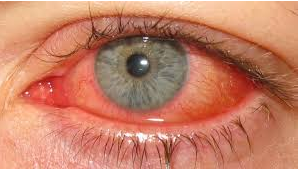The symptoms of conjunctivitis will depend on the cause, but generally include:
- Eye redness – this happens as a result of the inflammation and widening of the tiny blood vessels in the conjunctiva.
- Watering eyes – inflammation cause the mucus and tear glands to become overactive so that they water more than usual. Some forms may present a pus like discharge, and customers may complain of their eyes being stuck shut on waking in the morning.

The eyes are a delicate area and many other eye conditions can cause one or both eyes to be red such as shingles, glaucoma, iritis, uveitis or ulceration of the eye. These can all be mistaken for conjunctivitis so it is important to refer a customer to the pharmacist if you are unsure of the diagnosis.
Everyone can be susceptible to conjunctivitis, however there are some higher risk groups:
- Infective conjunctivitis is more common in the young and elderly.
- Those who have had recent eye surgery, laser eye surgery or other ophthalmic treatment.
- Contact lens wearers.
- Those who are immunosuppressed or immunocompromised.
- Those in close contact with someone with existing conjunctivitis.
- Customers suffering from blepharitis - an inflammation of the edge of the eyelid which can be caused by a bacterial infection resulting in conjunctivitis.
WHEN TO REFER?
If the customer describes any of the following red flag symptoms they should be referred to the pharmacist:
- Pain in the eye – mild soreness as opposed to pain is associated with conjunctivitis.
- Spots or blisters which have developed on the skin next to the eye.
- Vision has become affected.
- Suspected foreign body in the eye – these can sometimes be completely concealed within the conjunctival folds or within the eyelids.
- Lesion or injury to the eye.
- If the eye becomes very red, especially if it is on one side only.
- Photophobia develops (sensitivity to light).
- If the conjunctivitis is in a newborn baby less than 28 days old.
- Diagnosed shingles or chicken pox.
- Active cold sore infection as this could lead to a herpes infection in the eye.
- Conjunctivitis which has not responded to treatment.
This is not an exhaustive list and the usual referral criteria apply; if you have any doubts or concerns regarding the symptoms a customer describes, refer them to the pharmacist.
